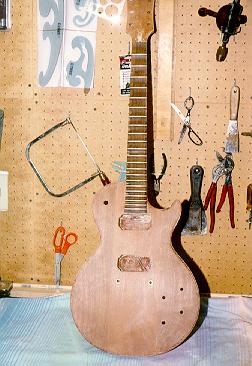

This is a work in progress, that I'll be reporting on as I go along. This guitar is genuine Frankenstein. The body and neck are 'factory seconds' from the Gibson factory. Gibson sold mountains of these parts in the early 80s to various music stores around the Chicago area, who then sold them as 'kits'. At least this is the story I'd been told. I bought mine in 1987 from a music store in Chicago, but have never been able to fit these components into the 'pantheon' of Pauls. The body is bound, front and back, as is the Custom, but it is of solid mahogany and lacks the typical Les Paul maple cap. The neck was unbound, dot-inlayed, more typical of a Junior or a Special than any of the higher end Les Pauls. I recently saw, in a mail-order catalog, a Les Paul model called "The All-American Paul 2" which is the closest I've ever seen to describing this set of components, except that the pictured specimen lacks binding of any kind on the body.
In retrospect, I would have selected at least another neck, one that had a properly cut tenon. I discovered that I was not quite up to the technical challenge of mating these miscut components. I did not have the skills and I did not have the tools. I got them together, eventually, but it's not the cleanest job of woodworking you're likely to see. From a neck that would not fit I created one that was way too loose. I then had to build up the joint with shims and putties. It was such a mess in fact I that I eventually set the guitar aside for almost 3 years as hopelessly botched. I finally decided that it wasn't THAT bad... not ideal, to be sure, but not totally worthless, and took it back in hand and completed the job.
This was my second attempt at a scalloped guitar, incorporating lessons learned from the 'Prototype'. The job was bigger, as there were more frets, but only took about 2 and a half weeks to complete. Once again, as with the prototype, due to lack of tools and skills the fingerboard is not properly dressed. I merely levelled the frets with a flat file and then smoothed them with fine sand and emory paper.
After completing the neck, I scraped the binding down to be flush and filled the many gaps with wood filler. I used a Leo Quann Baddass bridge, a fully-adjustable stud-compatible replacement bridge for the non-adjustable combination bridge/tailpiece that Gibson used on the original Les Paul, as well as the Junior and Special models back in the 50s. The tuning machines were black, nylon cased Schaller M6 minis with pearloid buttons. Pickups were Seymour Duncan Jeff Beck models, each with single coil/dual coil tap operated by push/pull switches under the volume controls.
I finished the guitar natural using polyurethanes. My first effort was with spray polyurethane, but this material seemed to dry too quickly to allow the finish to 'flow out', so I stripped it off and tried again, following advice from a carpenter friend, with brushed polyurethane. The result was proof that what works well for cabinetry does not necesarily work for guitars. Getting even coverage with a brush is virtually impossible on such a shape. Far worse though is that the final finish is much to soft. I was able to scribe the finish of this guitar with my fingernail! Add to that the fact that, though some of the 7 odd pieces that go into making up this body have interesting grain patterns, as a whole they don't really add up to much from an aesthetic standpoint. As soon as I was done, I knew that eventually I'd be taking this guitar back in hand for refinishing.
As you see, I have disassembled and stripped the guitar. I have also removed the faulty binding. During disassembly I discovered that a) I did a piss-poor job of grounding the sheilding, and b) some of the small slabs used to composite the body have been parting company with some of the others. I intend to repair these cracks. The back will be bound in ivory/black/ivory multi-layer binding and the front will wear a herringbone purfling surrounded by ivoroid binding. Overall the instrument will be finished in black nitrocellulose lacquer. I feel I now have the skill with finishes to pull off such a finish. I intend to fill the existing tuning machine holes and recut the headstock into a new shape, yet to be designed. I've never been overly fond of the stock Gibson shape. I don't consider this guitar to be a copy, so I don't feel I need to use the shape.
Though originally completed without a pickguard, when reconstructed the guitar will have a black, floating pickguard of the typical Les Paul pattern. I will reuse the originally single piece bridge, but will replace the black and pearl tuners with all chrome Schaller M6s. These machines are larger than the existing set and I think they will be more proportional to the instrument. Chrome hardware will replace existing brass fittings. This time I intend to fully finish and dress the fingerboard and to cut a new nut. I will also add position markers, made of cherry probably, to the fingerboard. For electronics, the original setup will return: Seymour Duncan humbuckers in conventional, 2 pickup configuration but with the addition of coil taps for each pickup activated by co-axial push/pull switches under the volumn controls.